NDVI stands for "Normalized Difference Vegetation Index". NRG stands for "Near-infrared / Red / Green". NDVI and NRG are both ways to visualize the amounts of infrared and other wavelengths of light reflected from vegetation. Because both these methods compare ratios of blue and red light absorbed versus green and IR light reflected, they can be used to evaluate the health of vegetation. It's a snapshot of how much photosynthesis is happening. This is helpful in assessing vegetative health or stress. (Read more here: https://www.agronomy.org/publications/jeq/articles/36/3/832) ## Do-It-Yourself These techniques for vegetation analysis were developed for satellite imagery, but at Public Lab, we've been working a lot on capturing infrared imagery using our DIY [near-infrared camera](/wiki/near-infrared-camera) setup, and combining it with visible bands to produce NDVI images such as the one above. ## What these images mean What exactly are these images we're trying to make? What do they tell us about vegetation, and why? These diagrams should help to understand what it is we're doing and why these are good ways to analyze plant life. ## The NDVI equation [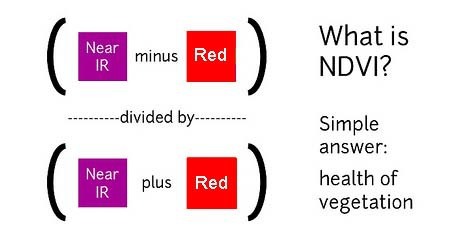](/i/44723) **NDVI = (Near Infrared - Red)/(Near Infrared + Red)** NDVI is a ratio which tries to emphasize photosynthesis while filtering out sun glare. The above equation is run for every pixel, using source data from an infrared photo and a visible light photo, like this pair: [](https://publiclab.org/system/images/photos/000/021/771/original/5390895115_c9d4d38fec_o.jpg) The result can be false-colored to make the high-photosynthesis areas more clear, and used to examine where plants are and how healthy they are. [](https://publiclab.org/system/images/photos/000/021/770/original/PetVISNDVIcomp.png) _Figure above: Normal color photo (right) and normalized difference vegetation index (NDVI) image (left). NDVI image was derived from two color channels in a single photo taken with a camera modified with a special infrared filter. Note that tree trunks, brown grass, and rocks have very low NDVI values because they are not photosynthetic. Healthy plants typically have NDVI values between 0.1 and 0.9. -- @cfastie_ ### Activities Here are a range of activities you can do to produce and interpret your own NDVI imagery, whether downloaded from a satellite imagery provider or [collected yourself using a DIY technique](/wiki/multispectral-imaging) [activities:ndvi] ****   Most DIY converted cameras today (those from Public Lab) use RGN instead of NRG, so the blue channel represents infrared instead of the red channel. That looks like this: [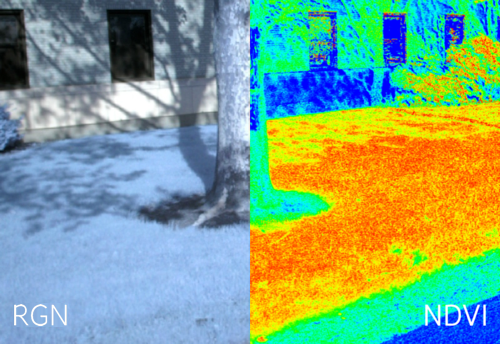](/i/45468?s=o) **** ## NRG imagery Some people are also interested in producing NRG imagery (like the below image), where `Near-Infrared, Red, and Green` are used to compose a picture instead of the usual `Red, Green, and Blue`. [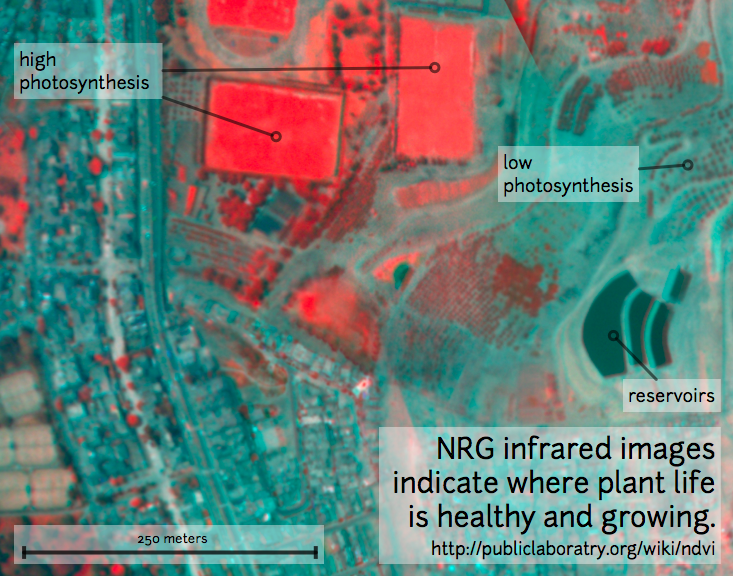](/i/25064) This diagram explains the swapping, which allows us to 'see' infrared as if it were a normal color: [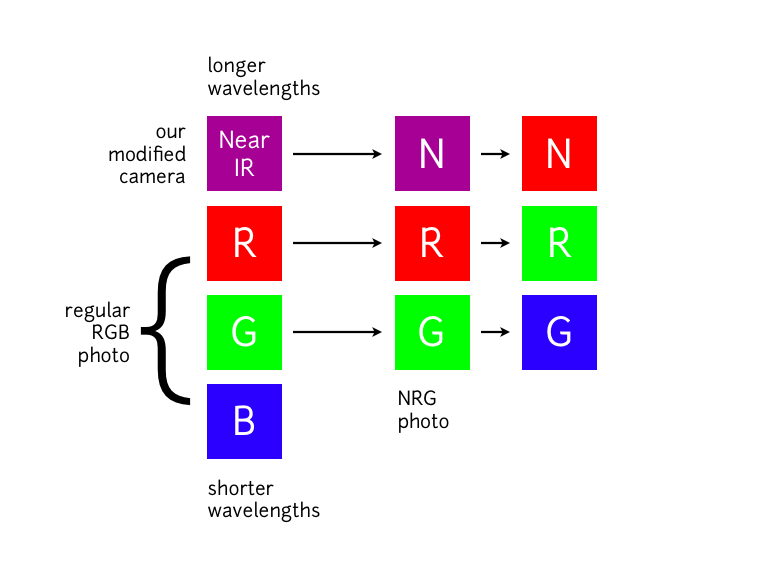](/i/25063) **In NRG images, the deeper and clearer the red color, the denser and healthier the vegetation (more or less).** ### Questions [questions:ndvi] ### Other examples of DIY NDVI imaging From around the internet: Begin watching at 2 minutes to see the resulting imagery: *This topic is part of the [Grassroots Mapping Curriculum](/wiki/mapping-curriculum) series.* **** [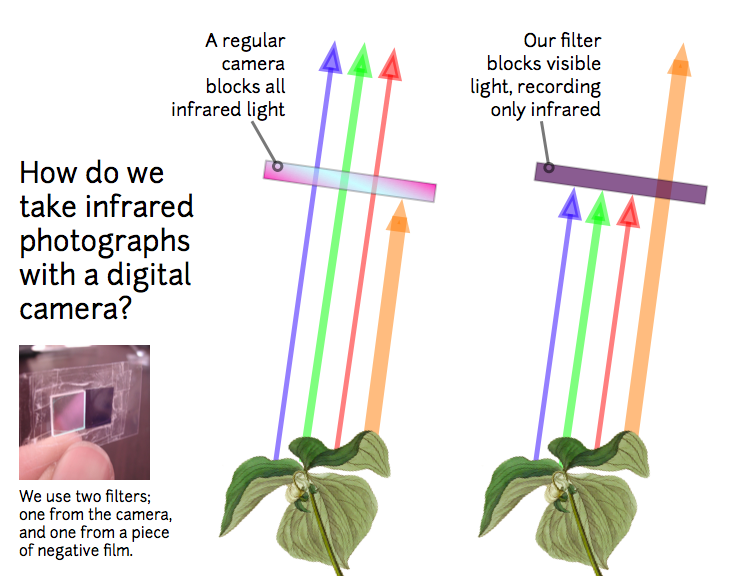](/i/25066) [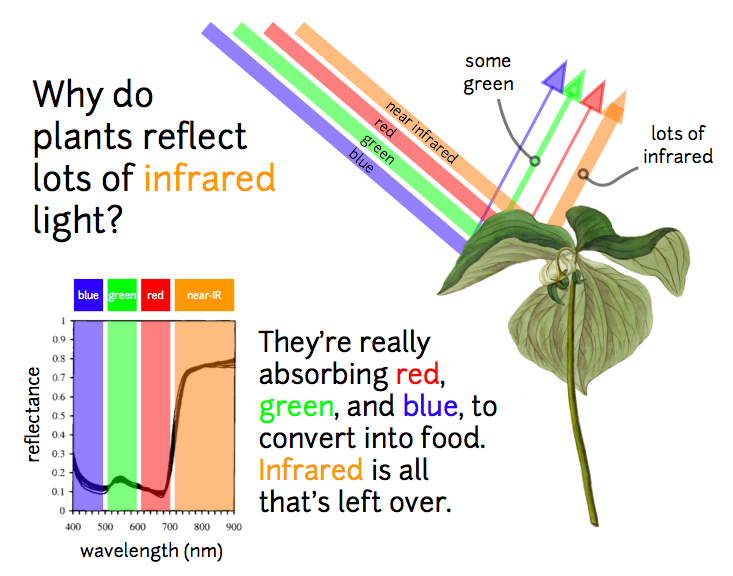](/i/25065) ...
| Author | Comment | Last activity | Moderation | ||
|---|---|---|---|---|---|
| warren | "Ah oops, i'd already linked to it! Sorry! " | Read more » | over 10 years ago | |||
| warren | "That'd be great - perhaps we could coordinate some kind of public outdoor activity. Are you on the boston discussion list? http://publiclab.org/lists " | Read more » | over 10 years ago | |||
| dsittenfeld | "Hi wow! Hadn't noticed all of this activity; thanks for the great ideas and links. I'm hoping to do more of this over the summer and would be happ..." | Read more » | over 10 years ago | |||
| warren | "http://publiclab.org/notes/warren/6-6-2011/chlorophyll-imaging-track-algal-blooms may also be a good resource. " | Read more » | over 10 years ago | |||
| patcoyle | "Very nice use of 3D design and printing for a specific one-off project. Exemplary. " | Read more » | over 10 years ago | |||
| mathew | "this is really cool. I made mine out of paper and tape " | Read more » | over 10 years ago | |||
| mathew | "I'm surprised at the IR passing of the Powershot. nice research. really should buy some of those NIR LEDs myself. " | Read more » | over 10 years ago | |||
| cfastie | "Is the levels stretching you are referring to the same thing as histogram stretching? If so, it should be high priority. If the look up table feat..." | Read more » | over 10 years ago | |||
| warren | "As i pointed out in the comments here yesterday, this HSV approach is pretty interesting and conceptually fun, but not ideal for real work with LUT..." | Read more » | almost 11 years ago | |||
| warren | "Corrections made re: order of operations, thank you Chris for a sharp eye and a clearer memory of how to do basic arithmetic! And you said you coul..." | Read more » | almost 11 years ago | |||
| warren | "Mathew only sent me one raw image: " | Read more » | almost 11 years ago | |||
| cfastie | "It looks like you've done a good job matching the NDVI index from the two cameras. It's hard to evaluate the meaningfulness of the NDVI images beca..." | Read more » | almost 11 years ago | |||
| nedhorning | "I think it might be possible to work on a simple calibration process that could be used to get decent NDVI values. I don't think there is much a us..." | Read more » | almost 11 years ago | |||
| mathew | "This isn't working for me either. I get a red or blue image, but not a NDVI-style color map. " | Read more » | almost 11 years ago | |||
| donblair | "Yeah! It's fun to picture this device being used in the mode of an old-fashioned 'light meter' held next to an infragram camera and which accounts..." | Read more » | almost 11 years ago | |||
| warren | "wow, sweet -- i wonder if this could also be used to calibrate NDVI with a more absolute brightness measure. Ned would know more about this... " | Read more » | almost 11 years ago | |||
| warren | "...the plant pixels will have the biggest values for both R and B and the difference between them is therefore likely to be bigger. Yeah, the idea..." | Read more » | almost 11 years ago | |||
| santizion | "Thanks Chris, now I have it!. Santiago " | Read more » | almost 11 years ago | |||
| cfastie | "Santiago, You can download that look up table at this page; http://publiclab.org/wiki/photo-monitoring-plugin. Copy it into the luts subdirectory i..." | Read more » | almost 11 years ago | |||
| santizion | "Andres, de que parte de argentina sos? Podriamos contactarnos asi nos damos una mano te parece?, Saludos " | Read more » | almost 11 years ago | |||
| santizion | "Markdown Hi guys, I´ve been reading this posts and they are very helpfull for me as well, but I am having some problems also with the PhotoMonitori..." | Read more » | almost 11 years ago | |||
| santizion | "no te preocupes, preste un poco de atención y estamos en la misma...jaja! te paso mi mail asi nos contactamos y nos damos una mano, yo estoy con un..." | Read more » | almost 11 years ago | |||
| santizion | "Andres, a quick question? Where are you from? Santiago " | Read more » | almost 11 years ago | |||
| mfornale | "Ciao Alberto, i'm working on something similar, I have modified a couple of cameras. See some results on www.agriculturaluav.eu Marco " | Read more » | almost 11 years ago |